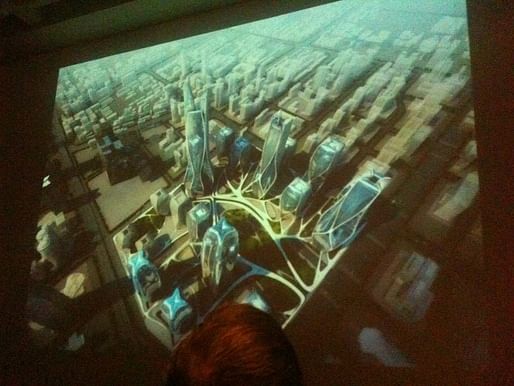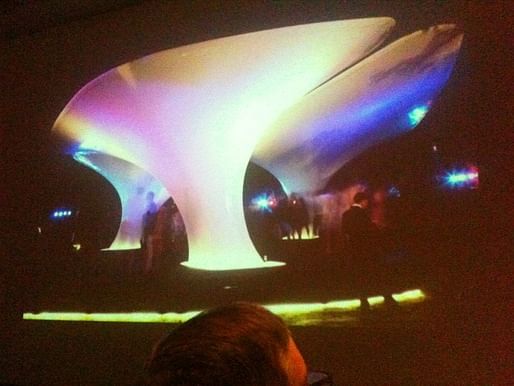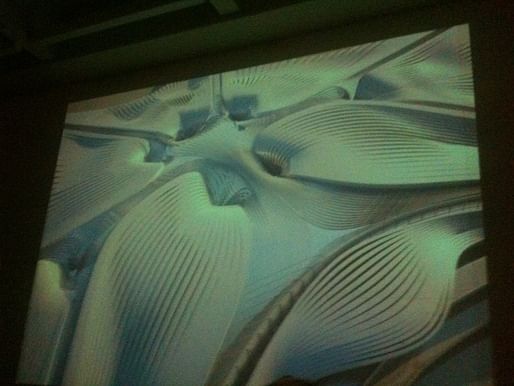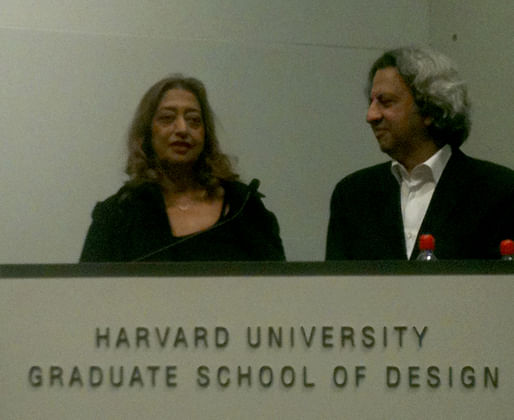
Hi Archinect,
You can watch the full video of this event at the GSD's YouTube Channel.
6:29: Zaha's in the house tonight. There was a huge line in the lobby--she's obviously one of the few architects who attracts such large non-architect audiences. The lecture is apparently untitled. It's already kinda warm in here...and there are what look like two bottles of Evian water on the podium.
6:32: Patrik Schumacher and Zaha Hadid just came in with Mohsen. Excitement.

6:34: Mohsen: "Good evening; it seems to be a really good mood. I'm happy you're all here and particularly happy that Zaha is here. It's been some time since she's been here so it's great she's back." He's commenting that it's been quite a week with Marina Abramović here earlier, as Abramović and Hadid have "liberated their fields." Construction was in a completely different state [before Hadid came on the scene].
"I'm so happy she's my friend; we have known each other since the very first day of school, which was a long, long, long time ago. And we have managed to still stay friends; it's important to say that Zaha really stays friends with people and more than any of us she is the one who has been keeping up friendships, caring for people, supporting people; and that's an important thing for a person of her stature. I am wearing a suit that she made me buy; [wearing it] in her honor tonight. ...It's a suit you can put in your suitcase and it never creases, so I am always thanking her for this suit." [laughter]
"...When she first started to develop her work, some people talked about how it was about the calligraphic line. Recently we had Patrik Schumacher here, her collaborator and partner who is convinced of the role and importance of parametricism. It's interesting to see how the office has managed to bridge that line, between the calligraphic and the whole domain of digital culture and the impact of computation on the firm."
"When she was drawing by pencil, drawing pencil."
Hadid: "Ink"
Mostafavi: "yes, ink...it was not a single line with orthogonal perfection with a single weight; the pen has the fluidity of something that is rendered with a brush. Her early interest and influence was very much to do with the question of Suprematism. ...the line that I believe became very important even though they were never built, like the Peak. ...It's important how drawing has been part and parcel of her project. This is something that needs further careful evaluation in its connection to landscape, painting, and so on. It was evident with early projects such as the Vitra fire station."
Hadid: "I'm embarrassed to say how long I've known him; it's been 40 years. We still both look young [so you wouldn't know it.] ...We're still friends, despite my bad behavior. ...I promised I wouldn't tease him tonight, [that was my role]."
"I do worry with the flirtation of certain friends of mine with certain moments in history--the 70s--we shouldn't forget what we went through." ...I was ostracized; nobody ever thought I'd build anything. I actually didn't mind, enjoyed drawing [and experimenting; and my office of 400 continues that.] "There's a reason why corporate offices work the way they do. So we try to change the rules.
"And there are many friends here tonight who I've known since my childhood, or New York, Miami,"so it's nice to have so many present here. The first time I was here, I was invited by Harry Cobb, then later to teach by Mack. I will say I was severely attacked by one of your tenure faculty. It was interesting; I used to smoke. I said to Mack: I smoke. And he said as long as nobody sees you, it's OK. And I smoked everywhere. I've since given up smoking, so I'd be accepted at Harvard now. But I also wore funnier clothes."
[A few more reminiscences of times when Hadid has been at the GSD. Apparently she was with her students at one point, maybe in the lobby, chatting and smoking, and someone came up to her and told her that she "was a bad influence" on her students. But she's remained friends with many of her students. Later, Hadid jokes that some of her students must still have nightmares about her.]
6:49: Slideshow begins. [It was extremely fast, sometimes 1 second per slide, so I'm sorry that this doesn't make much sense. I don' t have all the slides in the right order, either, so just breathe and let it all wash over you.]

Contemporary Arts Center Cincinnati. One question there was landscape. Another was how to occupy structure.
Bridge.
Master Plan for Singapore.
Early sketches of Rome; the idea of a confluence of lines, a striation of lines and how they intersect and bifurcate, making a delta of streams.
The idea of striation on the skyline, on the roof. So the idea of fluidity and landscape begins to appear in some of these earlier projects.
The house in California, ten years is still being worked on. It's been redesigned at least five times.
We did build a house in Moscow.
This is a house that's two houses, one on the ground (more public), and a more private world where the sleep at the top. The person who is in charge of this project is one of Patrik's favorites [not one of Hadid's favorites]. The house is [perfect] because Helmut is a perfectionist. [There are jokes about people leaping from high places which I will not quote out of context.]
“And of course the client [will be] exhausted, and never make it up the stairs to their bedroom. They’ll stay in their sauna on the ground.”
Science museum next to the Volkswagen factory. The idea of occupying structure from the bridge appears from this building.
The floor slab is quite thick, so there’s no need for columns. You can see the structure on the inside. The grid is uneven. The sketch for the structure was originally done with Hanif Kara.
A project with blue and white collar workers working in the same space; an office building. Like a filter. It’s like the GSD, with terracing. The idea that landscape comes into the interior of the workspace.
The other building done as a competition that year was Montpelier, an archive and library; a sectional building. The spaces are like rocks; the solid areas are archives that don’t require light. The glassed-in areas are all the public areas. Opened last summer. They call it “living stones.” The idea of a cluster or aggregates of spaces has appeared in other projects, like Cincinnati . There are three programs in one building.
The thing that makes it also work is that the lines [of the mullions and louvers] are relentless…and like a drawing. They move you up through the building when you arrive.
Similar scale is the museum in Glasgow; which is a metal shed, on the corner of two rivers. Very close to large shipyards. So it’s a roofscape that is also like a landscape. It’s very crowded with objects.
They iterated on the color quite a bit. Hadid wanted white; the client wanted color, so she picked canary yellow because it’s a color that you can see even if you’re colorblind. “I’m surrounded in the office by people who can’t see color, so I know…”
This is another project completed recently in Michigan, the Broad Art Museum. It’s a pleated stainless steel surface; each of these segments is a gallery; by perspectivally stretching these galleries they seem much bigger.
The vertical pleats are where the staircases are.
“The idea of topography and landscape came about around 23 years ago when we were working on a harbor development in Dusseldorf. …The interior is like an oyster; pre-formed gypsum.
Another project in China, like flowers in a park.
Even the interiors are graphic, like a graphic space. Not through drawing but through computation, with exaggerated black lines.
These are theaters we’ve worked on for the past 20 years…
There’s a new theater in Rabat, where the idea is that through a twist in the landscape you form two theaters, one interior and one exterior.
A contrast between the fluid exterior and a prison-like interior.
Another project on the ground is the design center in Seoul, which is basically a park; you can walk over the building. All metal-clad.
The idea of rice fields and terracing. It’s not a tower, or a series of towers, but a field of an almost mountainous scape that connects on different levels. One datum is on the ground and another is higher up. The one on the ground is all retail and the one above is all offices. A series of egg-like buildings with their own voids. It’s going to be called galaxy because of that [similarity in plan]. “That was an afterthought, of course.”


1 million square feet. As you enter the valley you’re immersed in a world where these bridges and hills are surrounding you. Every kind of building is slightly different.


This is another project in China; this is the one that was copied, literally. But my view is that I’m not going to sue everybody. Copying is a kind of learning curve. I know how they got the drawings, though. It’s better to [spend your time creating than suing everybody].


After 9-11 everybody thought nobody would build a tower, but the opposite has happened. Everybody wants to build a tower. The one thing we looked at from the beginning is how it touches the ground. Does it [just meet the ground] or flare up to make a big lobby, etc.



A masterplan with an exoskeleton and a variety of voids. The building bifurcates and connects again. It gives you amazing views and spaces.
Do the buildings meet the ground at a very delicate point, or do they form a large lobby or retail?

A competition for a New York tower next to the Seagram Building.

Tower in Baghdad.

Recent studies for a mixed-use project. Twisted spaces.



Chanel pavilion which moved around to different cities; Hong Kong, Tokyo, New York, Paris.

This is a study for the new Serpentine gallery. Tensile shell-like structure with columns that are in steel, allowing light into the building. Managed to get the planning permission because it’s a lightweight structure, attached to the brick building.
This is a project which is basically three projects. A library, a conference center, and a museum; three buildings becoming one building connected through a very large lobby.
[Dean Mostafavi opens a bottle of water for Hadid.]
Most of the fabrication of the interior was…laminated wood, done in Turkey.
Ribbed shells…many studies of different projects…most in the middle east.
Unfortunately during the games, they blackened all of these out. They called it “dressing,” they dressed up the pool. Mostly advertising.
The wavy roof; concrete diving boards. Another project for another pool complex.
Tokyo National stadium, an exoskeleton; again a shell, that is hollowed out and covered in fabric, so you have the option to open it up.
An airport with a structure and plan that resemble a flower. The idea with the flower shape is that you can move from one place to any other very easily.
Mohsen: I’m very curious about the end. When you did the Peak, you used to talk about confetti. When you did the drawings, they don’t really have much curvature in the big drawings of the peak itself. The idea of fragments, or dispersal, as if the project was coming apart, was important for you. It seemed to be about how the project might have a totality but it was denied…with the separation or coming apart of elements.
In a tower it’s hard to make a tower come apart. So you’re dealing with structural totality. Or the flower, it is unfolding, but in a sense it has that objecthood; it has a totality. So I’m curious about the shift from the spatial conditions that defy the notion of totality, to projects that are concerned with the notion of wholeness, like the flower. Where do you think this investigation is going? Because of the way you described the shell structures; in terms of the future of architecture for you, what is there? Some of the structures that seemed impossible, you’ve built.

Hadid: In terms of urbanism we have a long way to go. Not a city but sections of a city. We’re still dealing with normal street patterns. Transportation hasn’t changed very much. That would be the next investigation. On the level of the building itself, in a way, the fragmentation and all that chaos on the level of the city that was shown in the drawings, was almost sucked in the building much more through a fluid morphology than through fragmentation.
Mohsen: This is something that is important in terms of how you’re working with the various consultants? How do they come into the office, for you?
Hadid: The engineers are from the start with us.
Question from a student: One of the qualities I enjoy the most in the work is the feeling that there’s a connection between the mind and the hand, and the expressiveness. It’s hard sometimes, when I’m clicking in Rhino. As you develop tehse forms in the office how do you translate between drawing and digital space?
Question: Your work has changed over the years but has always had an intensity, a notion of excess. But what do you think remains and will stay consistent in your work?
Hadid: The idea of a civic domain, which wasn’t very obvious. It took a while for it to be interpreted; what is our intention at the civic level? The other thing is the idea of lightness; it moved from the idea of fragment to the landscape and the ground condition, whether it’s broken or separated. I always thought the most powerful layer was the ground condition. It wasn’t negated completely negated by the modernists but [still needed to be addressed], to enrich it.
Mohsen: But..the buildings are becoming larger, so the city, or that public space is becoming internalized.
Hadid: not always...if you’re in Europe or North America or China where the weather is quite harsh. [So it’s interesting to think about the public domain there.]

Question from a student about pleasure and architecture?
Hadid: At the end of the day I think space is supposed to enrich your life. Not to be corny, but that’s what I think it should do. Whether it’s an interior or exterior space. Those of us who are lucky, have a home. But not everybody has a luxurious place to live which is why it’s important to have [good public spaces]. How to create spaces that give people tremendous pleasure?
A small project—in a hollow—the way it was placed…and geometry has a big play in how a space can feel good. And I’m semi-puritanical, but I also think people should have fun.

Mohsen: It was nice to see you doing the project in Baghdad. You used to have strong ideas about the role of modernism in Baghdad.
Hadid: …
[about a specific neighborhood in Baghdad that Hadid knew well]…Naively, I always thought of that area as the same. I’d ask what it was like, and people would say it was completely dilapidated. Because so many people left [twenty years before].
Question about the early steps of design.
Hadid: The rules have changed; it used to be that we’d start with a sketch or drawing. If I do that now, they don’t know what I’m doing. I used to get very excited about drawings, models; that’s gone. They can’t draw, make models, they don’t understand what I’m saying. Only quite recently—there’s Patrik, who used to be my translator, who doesn’t translate anymore. …You have to have your own repertoire. My common word is “I don’t like it.” Those who don’t know me in the office [don’t know what that means.] I haven’t shown the most recent work, with two very young teams. Students of Patrik’s that Hadid “grabbed.”
Masterplans for various cities. A twist, a peacock, a feather. A feathering, and what that implies, with roofs. It’s kind of like calligraphy, but when you’ve done it for a few years, you’re thinking that’s a building with a tail, and you know some of the [material constraints].
End.
Thanks for reading.
Lian
P.S. Do you like emoji (emoticons)? I made an online photo booth and gallery that lets you make and share your attempts at emoji faces. Check it out and let me know what you think at me-moji.com.

This blog was most active from 2009-2013. Writing about my experiences and life at Harvard GSD started out as a way for me to process my experiences as an M.Arch.I student, and evolved into a record of the intellectual and cultural life of the Cambridge architecture (and to a lesser extent, design/technology) community, through live-blogs. These days, I work as a data storyteller (and blogger at Littldata.com) in San Francisco, and still post here once in a while.



2 Comments
What an amazing job you have done to transmit the lecture to us! Many thanks!
It is funny that she mentions her smoking, as there are some funny anecdotes about it when she taught at UIC in the early 90's.
Anyway, thanks for sharing.
Block this user
Are you sure you want to block this user and hide all related comments throughout the site?
Archinect
This is your first comment on Archinect. Your comment will be visible once approved.